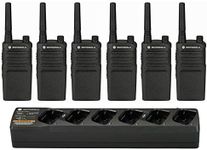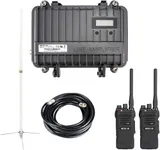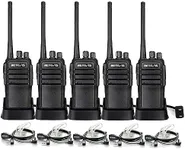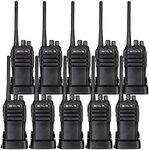Buying Guide for the Best Handheld Uhf Radios
Choosing the right handheld UHF radio can be a bit overwhelming given the variety of options available. UHF radios are essential for clear communication over short to medium distances, making them ideal for outdoor activities, business operations, and emergency situations. To make an informed decision, it's important to understand the key specifications and how they align with your specific needs. Here are the key specs to consider when selecting a handheld UHF radio and how to navigate them.Frequency RangeThe frequency range of a UHF radio determines the spectrum of frequencies it can operate on. UHF radios typically operate between 400-512 MHz. This range is important because it affects the clarity and distance of communication. For general use, a standard UHF range is sufficient, but for specialized applications like business or emergency services, you might need a radio that operates on specific frequencies. Choose a frequency range that matches your intended use and ensures compatibility with other radios you plan to communicate with.
Power OutputPower output, measured in watts, affects the transmission range of the radio. Higher power output means a longer communication range. Handheld UHF radios usually range from 1 to 5 watts. For casual use or short-range communication, 1-2 watts may be sufficient. For more demanding environments or longer distances, consider radios with 4-5 watts. Assess your typical usage scenarios to determine the appropriate power output for your needs.
Battery LifeBattery life is crucial for ensuring your radio lasts throughout your activities without needing frequent recharges. Battery life is often measured in milliampere-hours (mAh) and can vary widely. For occasional use, a battery life of 8-12 hours may be adequate. For extended use, such as during long hikes or work shifts, look for radios with 18-24 hours of battery life or more. Consider how long you need the radio to operate between charges and choose accordingly.
Durability and Weather ResistanceDurability and weather resistance are important if you plan to use the radio in harsh environments. Look for radios with a high Ingress Protection (IP) rating, which indicates resistance to dust and water. For example, an IP67 rating means the radio is dust-tight and can withstand immersion in water. If you need a radio for outdoor adventures or rugged work conditions, prioritize models with higher durability and weather resistance ratings.
Channel CapacityChannel capacity refers to the number of different communication channels the radio can access. More channels allow for greater flexibility in communication, especially in crowded areas where interference might be an issue. Basic models may offer 16-32 channels, while advanced models can have 100 or more. Consider how many channels you need based on your communication requirements and the number of users in your group.
Size and WeightThe size and weight of the radio can affect its portability and ease of use. Smaller, lighter radios are easier to carry and handle, making them ideal for activities like hiking or casual use. Larger, heavier radios may offer more features and better durability but can be cumbersome. Think about how you will carry and use the radio, and choose a size and weight that you find comfortable.
Additional FeaturesAdditional features can enhance the functionality of your UHF radio. Features like VOX (voice-activated transmission), GPS, emergency alert buttons, and programmable buttons can be very useful. Consider which additional features are important for your specific needs. For example, VOX is great for hands-free operation, while GPS can be crucial for navigation and safety in remote areas.






















